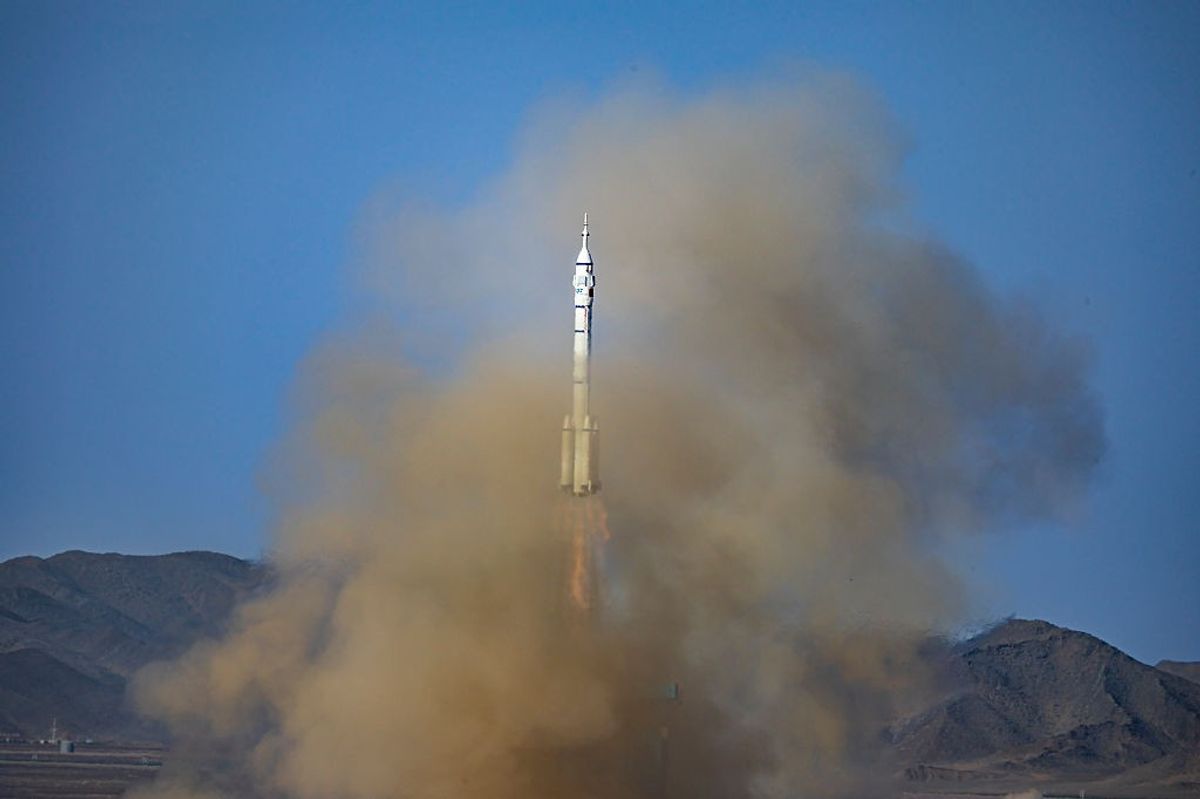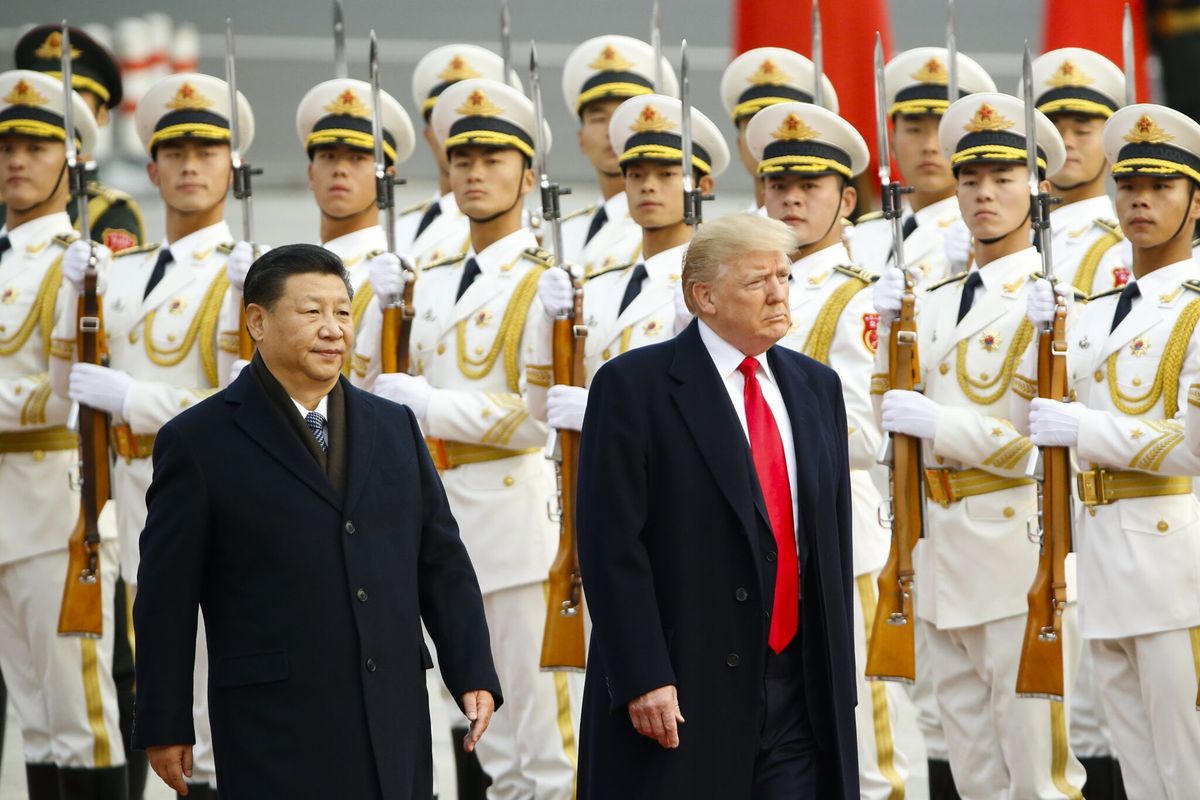SUBSCRIBER+ EXCLUSIVE REPORTING — The South China Sea is boiling again.
This month, the Philippines accused China’s coast guard of deploying water cannons and ramming maneuvers against Philippine vessels near the disputed Scarborough Shoal. The incident followed multiple near collisions and accusations of military interference and intimidation between the two countries in the South China Sea, all of which have sparked fresh fears of conflict in one the world’s most vital waterways.
“Anxieties have certainly increased,” Elizabeth Larus, a Nonresident Senior Fellow for the Atlantic Council Global China Hub, told The Cipher Brief. While Chinese Coast Guard vessels have blocked and harassed Philippine boats over the years, Larus said that “more recently, Chinese ships have adopted the use of lethal water cannons against Philippine resupply missions, injuring crew members.”
In March, a Chinese ship used its water cannon to smash the windshield of a Philippine vessel; several crew members were injured by the shattered glass. Chinese ships then rammed used water cannon against two other Philippine boats in April.
China claims vast swaths of the South China Sea, including areas claimed by the Philippines, Vietnam, Indonesia, Malaysia, and Brunei. An international tribunal ruled against nearly all of China’s claims in 2016, but Beijing has disregarded the ruling. Scarborough Shoal, the small atoll where the most recent encounter occurred, has been a flash point for more than a decade; in 2012, after a months-long standoff involving Chinese paramilitary vessels and Philippine government ships, China asserted control over Scarborough Shoal.
In recent years, China has backed up its claims with a large-scale civilian and military buildup on islands in the South China Sea. It has physically increased the size of some small islands and in some cases created entirely new islands by piling sand onto reefs. China has built ports, airstrips and military installations, and airstrips on several of these islands—and some are now home to fighter jets and cruise missiles.
“The South China Sea has surpassed the Taiwan Strait in terms of concern about crises escalating into conflict in the near term,” Zack Cooper, a Senior Fellow specializing in Asia Security issues at the American Enterprise Institute, told The Cipher Brief. “So, this is quite serious, and the risks of escalation are real.”
Why the South China Sea matters
The South China Sea is home to a trove of natural resources. It holds about 12% of the global fish catch, which is crucial for the sustenance and livelihoods of millions of people in the region, and its unexplored oil and natural gas reservoirs have been estimated at 11 billion barrels of oil and 190 trillion cubic feet of natural gas. These assets bolster the prosperity and economic prospects of several neighboring countries.
Beyond these riches, the South China Sea also holds significant strategic value as one of the world’s most critical trade thoroughfares. More than a third of the world’s maritime transportation passes through the South China Sea. It plays a crucial role in global commerce, facilitating the movement of goods worth over $3 trillion annually and linking key Asian economies to markets across Europe, Africa, and the Americas.
For these and other reasons, the South China Sea is also critical to U.S. interests. The area serves as an important passageway for the U.S. Navy and commercial traffic between the U.S. and East Asia. And in the ongoing U.S.-China competition for strategic influence, analysts have cautioned that as Beijing increases its footprint in the South China Sea, it could leverage that power to adversely affect the interests of the United States.
Put simply, a conflict in the South China Sea would bring both a geopolitical crisis and a profound blow to the global economy.
The U.S. role – and fears of a clash
Hostilities between China and the Philippines would almost certainly draw in the United States. The U.S. and the Philippines signed a mutual defense treaty in 1951, and more recently Washington has repeatedly pledged to protect its ally from any armed attack in the South China Sea.
“Washington cares about this for several reasons,” Cooper said. First, he said, China’s incursions into Philippine waters “blatantly violate international law...so this is about upholding the rules-based order. Second, the U.S.-Philippines mutual defense treaty puts obligations on the United States, and upholding the alliance is important to American policymakers.”
While the U.S. has recently stepped up its diplomatic expressions of support for the Philippines and other East Asian countries, the rhetoric has failed to temper Chinese aggression. That, says Eric Gomez, a security analyst and senior fellow at the Cato Institute, has left Washington in a difficult position.
“If the United States does more to provide material aid to the Philippines, say by escorting Philippine coast guard or military vessels, it will expose the U.S. to greater direct risk of a confrontation with China,” Gomez said. “The scenario I most worry about involves either Chinese or Filipino sailors being killed. Washington could face enormous pressure to support a treaty ally and demonstrate resolve and credibility in such a scenario."
While no Philippine naval personnel have been killed by China’s maneuvers, experts share Gomez’s concerns, given the violent nature of the recent run-ins in the South China Sea. Larus warned that the death of one Philippine crew member could “set off a chain of reactions.”
Article IV of the 1951 US-Philippine treaty states that in the event of any "armed attack” in the Pacific against either country, the other would be compelled to respond.
Earlier this month, following the latest round of skirmishes in the South China Sea, Secretary of Defense Lloyd Austin reasserted the U.S.’s “ironclad commitment to the Philippines.” In congressional testimony a week earlier, outgoing Indo-Pacific chief Adm. John Aquilino said the Philippines could invoke the 1951 treaty if any of its military personnel are killed in aggression with China. And late last year, the State Department said that “the United States stands shoulder-to-shoulder with our Philippine ally in the face of the People’s Republic of China’s (PRC) repeated harassment in the South China Sea,” and reaffirmed that “Article IV of the 1951 U.S.-Philippines Mutual Defense Treaty extends to armed attacks on Philippine armed forces, public vessels, or aircraft – including those of its Coast Guard – anywhere in the South China Sea.”
The way forward
Absent a major clash, or even a small-scale episode that results in fatalities, experts say diplomatic avenues remain. Those might include a blend of warnings and possible sanctions against China, and a continued push to strengthen regional U.S. security alliances – with Japan, Australia and India in particular.
“Although it may not appear fruitful, the U.S. needs to keep talking to Beijing, continually clarifying the U.S. position,” Larus said. “Washington must avoid drawing red lines. Given the tensions in the region, Beijing will certainly cross a U.S. red line at some point, forcing the U.S. to respond or back away, which would further embolden Beijing. So, if Washington insists on drawing a red line, it would be better to know precisely how to respond to China when that line is crossed.”
Presumably U.S. officials have already gamed out such scenarios, and in the absence of any American “red lines,” it’s not clear how China will be moved to back down in the South China Sea.
Kenneth Dekleva, a Senior Fellow at the George H.W. Bush Foundation for US-China Relations, cautioned that a weak U.S. reponse in the South China Sea could impact the other potential flashpoint in the region: Taiwan.
“The Philippines is a key American ally,” Dekleva told The Cipher Brief. " It goes without saying that if America doesn’t come to their aid, can it be counted upon to do so in the case of Taiwan? The Chinese assumption could well be, No, America will remain passive and disengaged.” He added that "right now, Xi perceives American leadership as weakened and preoccupied with domestic issues, especially our November election, and thereby, a more opportune time for China to probe further and test the waters.”
"I suspect the security picture in the South China Sea will get worse in the months ahead," Gomez said, "as the U.S. moves to demonstrate its willingness to protect the Philippines, and China keeps up its current behavior to show that it won’t be intimidated by Washington.”
SUBSCRIBER+ REPORTING — The South China Sea is boiling again.
This month, the Philippines accused China’s coast guard of deploying water cannons and ramming maneuvers against Philippine vessels near the disputed Scarborough Shoal. The incident followed multiple near collisions and accusations of military interference and intimidation between the two countries in the South China Sea, all of which have sparked fresh fears of conflict in one the world’s most vital waterways.
“Anxieties have certainly increased,” Elizabeth Larus, a Nonresident Senior Fellow for the Atlantic Council Global China Hub, told The Cipher Brief. While Chinese Coast Guard vessels have blocked and harassed Philippine boats over the years, Larus said that “more recently, Chinese ships have adopted the use of lethal water cannons against Philippine resupply missions, injuring crew members.”
In March, a Chinese ship used its water cannon to smash the windshield of a Philippine vessel; several crew members were injured by the shattered glass. Chinese ships then rammed used water cannon against two other Philippine boats in April.
China claims vast swaths of the South China Sea, including areas claimed by the Philippines, Vietnam, Indonesia, Malaysia, and Brunei. An international tribunal ruled against nearly all of China’s claims in 2016, but Beijing has disregarded the ruling. Scarborough Shoal, the small atoll where the most recent encounter occurred, has been a flash point for more than a decade; in 2012, after a months-long standoff involving Chinese paramilitary vessels and Philippine government ships, China asserted control over Scarborough Shoal.
In recent years, China has backed up its claims with a large-scale civilian and military buildup on islands in the South China Sea. It has physically increased the size of some small islands and in some cases created entirely new islands by piling sand onto reefs. China has built ports, airstrips and military installations, and airstrips on several of these islands—and some are now home to fighter jets and cruise missiles.
“The South China Sea has surpassed the Taiwan Strait in terms of concern about crises escalating into conflict in the near term,” Zack Cooper, a Senior Fellow specializing in Asia Security issues at the American Enterprise Institute, told The Cipher Brief. “So, this is quite serious, and the risks of escalation are real.”
Why the South China Sea matters
The South China Sea is home to a trove of natural resources. It holds about 12% of the global fish catch, which is crucial for the sustenance and livelihoods of millions of people in the region, and its unexplored oil and natural gas reservoirs have been estimated at 11 billion barrels of oil and 190 trillion cubic feet of natural gas. These assets bolster the prosperity and economic prospects of several neighboring countries.
Beyond these riches, the South China Sea also holds significant strategic value as one of the world’s most critical trade thoroughfares. More than a third of the world’s maritime transportation passes through the South China Sea. It plays a crucial role in global commerce, facilitating the movement of goods worth over $3 trillion annually and linking key Asian economies to markets across Europe, Africa, and the Americas.
For these and other reasons, the South China Sea is also critical to U.S. interests. The area serves as an important passageway for the U.S. Navy and commercial traffic between the U.S. and East Asia. And in the ongoing U.S.-China competition for strategic influence, analysts have cautioned that as Beijing increases its footprint in the South China Sea, it could leverage that power to adversely affect the interests of the United States.
Put simply, a conflict in the South China Sea would bring both a geopolitical crisis and a profound blow to the global economy.
The U.S. role – and fears of a clash
Hostilities between China and the Philippines would almost certainly draw in the United States. The U.S. and the Philippines signed a mutual defense treaty in 1951, and more recently Washington has repeatedly pledged to protect its ally from any armed attack in the South China Sea.
“Washington cares about this for several reasons,” Cooper said. First, he said, China’s incursions into Philippine waters “blatantly violate international law...so this is about upholding the rules-based order. Second, the U.S.-Philippines mutual defense treaty puts obligations on the United States, and upholding the alliance is important to American policymakers.”
While the U.S. has recently stepped up its diplomatic expressions of support for the Philippines and other East Asian countries, the rhetoric has failed to temper Chinese aggression. That, says Eric Gomez, a security analyst and senior fellow at the Cato Institute, has left Washington in a difficult position.
“If the United States does more to provide material aid to the Philippines, say by escorting Philippine coast guard or military vessels, it will expose the U.S. to greater direct risk of a confrontation with China,” Gomez said. “The scenario I most worry about involves either Chinese or Filipino sailors being killed. Washington could face enormous pressure to support a treaty ally and demonstrate resolve and credibility in such a scenario."
While no Philippine naval personnel have been killed by China’s maneuvers, experts share Gomez’s concerns, given the violent nature of the recent run-ins in the South China Sea. Larus warned that the death of one Philippine crew member could “set off a chain of reactions.”
Article IV of the 1951 US-Philippine treaty states that in the event of any "armed attack” in the Pacific against either country, the other would be compelled to respond.
Earlier this month, following the latest round of skirmishes in the South China Sea, Secretary of Defense Lloyd Austin reasserted the U.S.’s “ironclad commitment to the Philippines.” In congressional testimony a week earlier, outgoing Indo-Pacific chief Adm. John Aquilino said the Philippines could invoke the 1951 treaty if any of its military personnel are killed in aggression with China. And late last year, the State Department said that “the United States stands shoulder-to-shoulder with our Philippine ally in the face of the People’s Republic of China’s (PRC) repeated harassment in the South China Sea,” and reaffirmed that “Article IV of the 1951 U.S.-Philippines Mutual Defense Treaty extends to armed attacks on Philippine armed forces, public vessels, or aircraft – including those of its Coast Guard – anywhere in the South China Sea.”
The way forward
Absent a major clash, or even a small-scale episode that results in fatalities, experts say diplomatic avenues remain. Those might include a blend of warnings and possible sanctions against China, and a continued push to strengthen regional U.S. security alliances – with Japan, Australia and India in particular.
“Although it may not appear fruitful, the U.S. needs to keep talking to Beijing, continually clarifying the U.S. position,” Larus said. “Washington must avoid drawing red lines. Given the tensions in the region, Beijing will certainly cross a U.S. red line at some point, forcing the U.S. to respond or back away, which would further embolden Beijing. So, if Washington insists on drawing a red line, it would be better to know precisely how to respond to China when that line is crossed.”
Presumably U.S. officials have already gamed out such scenarios, and in the absence of any American “red lines,” it’s not clear how China will be moved to back down in the South China Sea.
Kenneth Dekleva, a Senior Fellow at the George H.W. Bush Foundation for US-China Relations, cautioned that a weak U.S. reponse in the South China Sea could impact the other potential flashpoint in the region: Taiwan.
“The Philippines is a key American ally,” Dekleva told The Cipher Brief. " It goes without saying that if America doesn’t come to their aid, can it be counted upon to do so in the case of Taiwan? The Chinese assumption could well be, No, America will remain passive and disengaged.” He added that "right now, Xi perceives American leadership as weakened and preoccupied with domestic issues, especially our November election, and thereby, a more opportune time for China to probe further and test the waters.”
"I suspect the security picture in the South China Sea will get worse in the months ahead," Gomez said, "as the U.S. moves to demonstrate its willingness to protect the Philippines, and China keeps up its current behavior to show that it won’t be intimidated by Washington.”
Read more expert-driven national security insights, perspective and analysis in The Cipher Brief.













